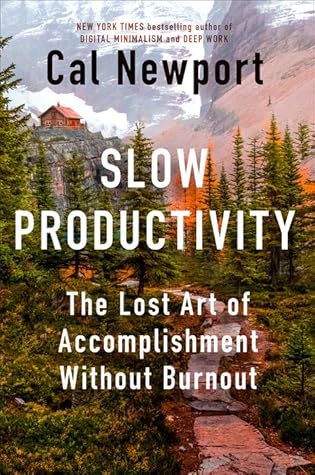More on this book
Community
Kindle Notes & Highlights
by
Cal Newport
Read between
March 21 - March 30, 2025
The relentless overload that’s wearing us down is generated by a belief that “good” work requires increasing busyness—faster responses to email and chats, more meetings, more tasks, more hours.
SLOW PRODUCTIVITY A philosophy for organizing knowledge work efforts in a sustainable and meaningful manner, based on the following three principles: 1. Do fewer things. 2. Work at a natural pace. 3. Obsess over quality.
As the twentieth century progressed, this visible-activity heuristic became the dominant way we began thinking about productivity in knowledge work.
PSEUDO-PRODUCTIVITY The use of visible activity as the primary means of approximating actual productive effort.
KNOWLEDGE WORK (GENERAL DEFINITION) The economic activity in which knowledge is transformed into an artifact with market value through the application of cognitive effort.
SLOW PRODUCTIVITY A philosophy for organizing knowledge work efforts in a sustainable and meaningful manner, based on the following three principles: 1. Do fewer things. 2. Work at a natural pace. 3. Obsess over quality.
PRINCIPLE #1: DO FEWER THINGS Strive to reduce your obligations to the point where you can easily imagine accomplishing them with time to spare. Leverage this reduced load to more fully embrace and advance the small number of projects that matter most.
This overhead tax activates as soon as you take on a new responsibility. As your to-do list grows, so does the total amount of overhead tax you’re paying. Because the number of hours in the day is fixed, these administrative chores will take more and more time away from your core work, slowing down the rate at which these objectives are accomplished.
In a factory, pushing employees to work longer shifts might be directly more profitable. In knowledge work, by contrast, pushing employees into larger workloads can decrease both the quantity and quality of what they produce.
We further established that toiling at maximum capacity greatly reduces the rate at which we accomplish useful things, as it chokes our schedule in administrative kudzu and splinters our attention into fragments too small to support original thinking.
Working on fewer things can paradoxically produce more value in the long term: overload generates an untenable quantity of nonproductive overhead.
In a push-based process, each stage pushes work onward to the next as soon as it’s done. In a pull-based process, by contrast, each stage pulls in new work only when it’s ready for it.
Shifting to a pull-based operation made backlogs impossible: the pace of the pipeline would adapt to whatever stage was running slowest. This transparency, in turn, helped the workers identify places where the system was out of balance.
pull workflows are a powerful tool to avoid overload in the knowledge work setting.
The key is to simulate a pull-based assignment system in such a way that the people you work with don’t even realize you’re trying something new.
The first step in simulating a pull-based workflow is tracking all projects to which you’re currently committed on a list divided into two sections: “holding tank” and “active.”
We suffer from overly ambitious timelines and poorly managed workloads due to a fundamental uneasiness with ever stepping back from the numbing exhaustion of jittery busyness.
PRINCIPLE #2: WORK AT A NATURAL PACE Don’t rush your most important work. Allow it instead to unfold along a sustainable timeline, with variations in intensity, in settings conducive to brilliance.
pseudo-productivity, which used visible activity as a proxy for usefulness.
A reality of personal productivity is that humans are not great at estimating the time required for cognitive endeavors. We’re wired to understand the demands of tangible efforts, like crafting a hand ax, or gathering edible plants. When it comes to planning pursuits for which we lack physical intuition, however, we’re guessing more than we realize, leading us to gravitate toward best-case scenarios for how long things might take.
“one for you, one for me” strategy. Every time you add a meeting to your calendar for a given day, find an equal amount of time that day to protect.
PRINCIPLE #3: OBSESS OVER QUALITY Obsess over the quality of what you produce, even if this means missing opportunities in the short term. Leverage the value of these results to gain more and more freedom in your efforts over the long term.
“Deciding what not to do is as important as deciding what to do,”
Jarvis’s story so heartening is its demonstration that these benefits of “obsessing” over quality don’t necessarily require that you dedicate your entire life to the blinkered pursuit of superstardom.
When you gather with other people who share similar professional ambitions, the collective taste of the group can be superior to that of any individual.
Give yourself enough time to produce something great, but not unlimited time. Focus on creating something good enough to catch the attention of those whose taste you care about, but relieve yourself of the need to forge a masterpiece. Progress is what matters. Not perfection.
Slowing down isn’t about protesting work. It’s instead about finding a better way to do it.
This is what ultimately matters: where you end up, not the speed at which you get there, or the number of people you impress with your jittery busyness along the way.


